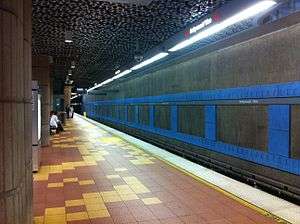Hollywood/Vine station
 Platform View | |||||||||||
| Location |
6250 Hollywood Boulevard Los Angeles, CA 90028 | ||||||||||
| Coordinates | 34°06′06″N 118°19′37″W / 34.101667°N 118.326944°WCoordinates: 34°06′06″N 118°19′37″W / 34.101667°N 118.326944°W | ||||||||||
| Owned by | LACMTA | ||||||||||
| Line(s) |
| ||||||||||
| Platforms | 1 island platform | ||||||||||
| Tracks | 2 | ||||||||||
| Construction | |||||||||||
| Parking | 60 spaces | ||||||||||
| Disabled access | Yes | ||||||||||
| Other information | |||||||||||
| Status | in service | ||||||||||
| History | |||||||||||
| Opened | June 12, 1999 | ||||||||||
| Services | |||||||||||
| |||||||||||
Hollywood/Vine is a subway station on the Red Line of the Los Angeles County Metro Rail system in Hollywood, Los Angeles.
Location
As the name implies, Hollywood/Vine station lies below the intersection of Hollywood Boulevard and Vine Street.[1] The central station of the three subway stops in Hollywood, it is within walking distance of many important landmarks including the Capitol Records Building. The Hollywood Walk of Fame is also upstairs, while the Pantages Theatre is across the street. Other attractions include CBS Columbia Square, the Frolic Room, Gower Gulch, the Sunset and Vine apartment complex, and the Hollywood Palladium.
Transit-oriented development
In accordance with Metro's initiatives to spur transit-oriented development around its stations, Hollywood/Vine has become a prime target for regeneration. The W Hotel opened a 300-room location in a 2.3-acre (0.93 ha) mixed-use site with condominiums and 30,000 sq ft (2,790 m2) of street retail space. In addition, the 1600 Vine complex to the south contains 375 apartments and 28,000 sq ft (2,600 m2) of street-level retail.[2]
History
Hollywood/Vine opened on June 12, 1999, as the western terminus of the northern branch of the Red Line. Upon the opening of the westward extension to North Hollywood in 2000, it lost its title as the end of the line.
Station layout
| G | Street level | Exit/Entrance |
| B1 | Mezzanine | Faregates, ticket machines, to Exits/Entrances |
| B2 | Northbound | ← |
| Island platform, doors will open on the left | ||
| Southbound | → | |
Like most stations on the Metro, Hollywood/Vine uses an island platform setup with two tracks. There is an entrance to the east of the intersection at Argyle Avenue.
Design

Each Red Line station was assigned a professional artist to design the aesthetic appeal and personality of the station. Local Los Angeles Chicano artist Gilbert Luján (aka Magu) was selected to design this station. "Light" was one of the central themes of the station because of its pervasiveness in Hollywood, from stars to light that passes through projectors to show films to the sun in sunny southern California. Cultural motifs in the form of So Cal cultural icons are also prevalent throughout the myriad of ceramic tiles lining the walls of the corridors as passengers descend into the railway tunnel. Benches for waiting passengers were fashioned as classic car lowriders on pedestals.
The station has, perhaps, the most detail and decorations of any station in the entire Metro system. This station is among the most pleasant and "fun" stations and tourists may find this station the most enjoyable. Other features include two movie projectors donated by Paramount Pictures pointed towards a representation of a movie screen flanked by large curtains. The ceiling of the station is covered with empty film reels. Pillars that provide support for the station are designed to look like palm trees, and beneath the handrail of the stairs are musical notes for the famed song "Hooray for Hollywood." Passengers making their way to the street follow the "Yellow Brick Road" while passing many colored tiles that depict icons or represent southern California lifestyle.

Bus connections
- Metro services
- Metro Local: 180, 181, 210, 212, 217, 222
- Metro Rapid: 780
- Other local services
- FlyAway Bus (hourly service to LAX)
- LADOT DASH: Beachwood Canyon, Hollywood, Hollywood/Wilshire
- Long-distance motorcoach
- BoltBus (to Oakland via San Jose and San Francisco)
References
- ↑ Red and Purple Line timetable LACMTA Retrieved 2011-06-06
- ↑ Metro's transit-oriented development program LACMTA Retrieved 2011-06-06
External links
| Wikimedia Commons has media related to Hollywood/Vine (Los Angeles Metro station). |